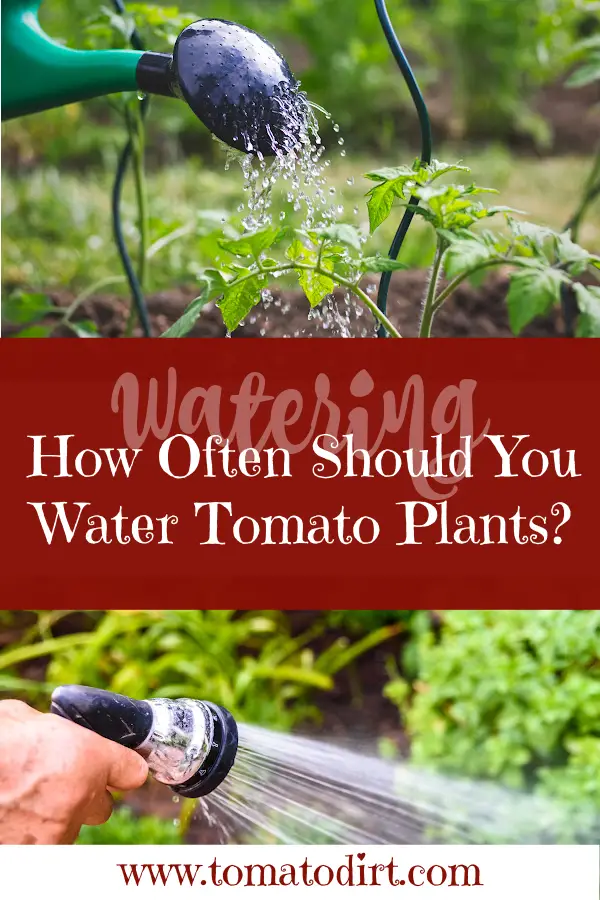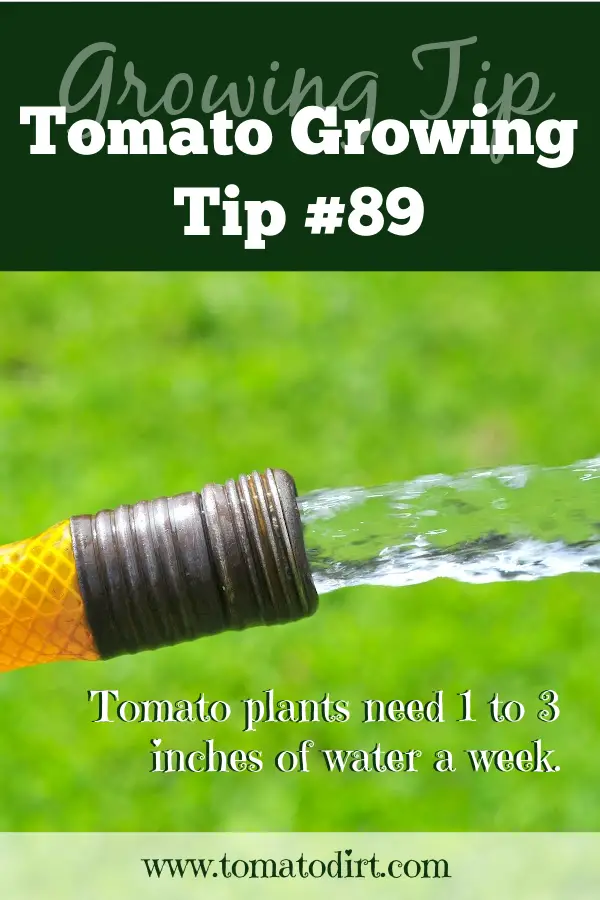FREE: 10 Must-Know Tomato Growing Tips Get The Guide
Read our affiliate disclosure here.
How Often Do You Water Tomato Plants?
Since 2010, Tomato Dirt has garnered 4.8+ million views, making it the web’s leading online source for growing tomatoes in the home garden. Award-winning writer and Tomato Dirt owner Kathy Widenhouse has helped thousands of home gardeners grow healthier tomatoes. Be one of them when you get Tomato Dirt’s Growing Guide here.
Updated 6.10.24
How often do you water tomato plants? There’s no one cut-and-dry answer (excuse the pun.)
Too little water and your plants wilt and produce less fruit. Too much, and you risk root rot and other diseases. And to be honest, it can be hard to know if your tomato plants are getting enough water.
Your watering plan must take several factors into consideration. For instance, plant to water brand new tomato seedlings on a different schedule than established tomato plants. And you water tomato plants in pots at a different frequency than those in your garden plot. Here are some frequently asked questions and answers about how often to water tomato plants.
Q. How often do you water tomato plants after planting?
Once you place tomato seedlings in their new homes in your garden, water them daily. Give each plant at least a quart of water each day, more if the weather is especially warm.
Q. How often do you water tomato plants in the ground?
Established plants get 1-3 inches a week of water (including rainwater) – closer to 1 inch if the weather is cool, closer to 3 inches if temperatures are hot. On average, that works out to 2 gallons of water a week for each plant.
But here’s the tricky part: you need to know your climate and your soil type.
Gardeners in moderate climates follow a simple rule of thumb: water tomato plants once or twice a week, providing about 1-2 inches of water each time. But what if your growing season temperatures are consistently above 80-85 degrees F for weeks on end? Then split up your watering schedule so plants get hydrated a couple of times a week. Ditto when you’re in a drought. And if you’ve got sandy soil, you know that it drains quickly, so plants need water more often than weekly. On the other hand, clay soil retains moisture longer, so you may need to experiment with your tomato watering schedule to determine the best way to get 1-3 inches of water into your plants each week.
Another tip: be consistent. If you pour 1-2 inches of water onto tomato plants all out at once, then fruit is likely to overindulge. That means tomato skins cannot expand fast enough to keep up with absorption, leading to cracking. Or inconsistent watering means uneven calcium absorption, leading to blossom end rot. Instead, water deeply and slowly.
And quick little sprinklings every day are not the answer either. Light watering keeps roots at the surface of the soil. Tomato plants grow best when they have strong, deep root systems.
** Best tips: ** Water deeply and slowly, about every three or four days, until fruit emerges. Use a moisture meter or simply stick your finger into the soil up to your second knuckle. If the soil feels dry at that depth, it’s time to water.
Q. How often do you water tomato plants in raised beds?
Raised beds generally drain better than ground soil. Plus, soil in raised beds warms faster than your garden plot, which means increased evaporation. Put together, that means tomatoes in raised beds need more frequent watering than your garden plot. Water tomato plants in raised beds every 2-5 days – on the more frequent end when temperatures are hot or you’re in a drought, and less often if the thermometer is more moderate.
** Best tips:** Mulch your raised beds with straw or shredded leaves to retain moisture and reduce the watering frequency. Consider drip hoses around your tomato plants in raised beds to ensure slow and deep watering.
Q. How often do you water tomato plants in pots?
Pots dry out faster than the ground or raised beds, especially if they’re made from materials like terracotta, which are porous. Plus, tomatoes in pots have limited space in which to spread their roots. During hot weather, you may need to water potted tomato plants daily, sometimes even twice a day. As for volume, plan to give your established tomato plant a gallon of water a day – more during the heat of the summer. Ensure the pots have drainage holes to prevent waterlogging.
** Best tips: ** Group potted plants together to create a microclimate that reduces water loss. Using self-watering containers can also help maintain consistent moisture levels.
Q. How often do you water tomato plants in hot weather?
Heat won’t kill your tomato plants if they get water. But be aware that temperatures consistently higher than 90ºF and nights consistently above 75ºF create extra stress. Plants abandon their work to produce blossoms and fruit and simply move into survival mode.
While deep watering a couple of times a week is typically best for tomato plants, a heat wave is not a typical situation. During hot weather, water your tomato plants daily, but give them less volume. You can return to twice-weekly deep soakings when the temperature breaks. And when weather is hot, consider providing relief for plants with shade cloth, particularly from 10 AM to 2 PM during the heat of the day.
** Best tips: ** Water early in the morning or late in the evening to reduce water loss through evaporation. Avoid wetting the leaves to minimize the risk of fungal diseases.
Q. How often should you water tomato plants in a greenhouse?
Greenhouse conditions can vary significantly, but they generally stay warmer and more humid. This environment can reduce how often you need to water tomato plants. But monitor your greenhouse tomatoes carefully to prevent the soil from drying out or becoming too wet.
** Best tips: ** Install a drip irrigation system with a timer to provide consistent moisture without overwatering. Keep an eye on humidity levels to prevent fungal diseases.
Q. Should you mist tomato plants?
When your tomato seeds are preparing to sprout – and just after tomato seedlings push through the soil and have one or two sets of leaves – misting is okay. But beyond a seedling’s first week or two of life, do not mist them.
Misting broadcasts water on a tomato plant’s leaves, stems, and fruit. That opens up all kinds of opportunities for fungi and diseases to spread. Avoid misting. The best way to water tomato plants is to use drip irrigation or a garden hose at the base of the plant.
Q. Are you watering tomatoes too much?
Can you overwater tomato plants? Yes. Tomatoes, like most veggies in the garden, need an inch of water a week and up to 3 inches if it’s particularly hot. That translates into about two gallons per plant. And don’t forget – that includes rainfall.
But overwatering or quick watering means excess liquid pools on the surfaces. Soggy soil chokes your tomato’s roots and prevents them from getting oxygen. Bottom line, over watering drowns your tomatoes.
You’ll recognize overwatered tomato plants by yellowing stems and leaves, which may develop brown edges. As for the fruit, the interior of a tomato expands quickly when it takes in water but the outer skin can’t keep up. Too much water delivered too quickly leads to tomato cracks. And if you suspect you’re overwatering, take a peek under the soil. A healthy tomato plant’s roots are pale, but an overwatered tomato plant has slimy, darkening roots.
If your plant is overwatered, you can gently lift it from its position in the garden (being careful to gather the root ball and surrounding soil) and move it to a container or a protected area. Let the roots dry out and then replant.
And readjust your watering schedule.
Q. What else should you watch out for with your watering frequency?
- Check watering depth. Ensure water penetrates deeply to encourage deep root growth. Shallow watering can lead to weaker roots and less resilient plants.
- Water consistently. Avoid letting the soil dry out completely between waterings. Dry soil for extended periods is stressful plants and in particular can lead to blossom end rot.
- Mulch tomato plants. Apply mulch around plants to retain moisture, regulate soil temperature, and reduce weeds.
- Avoid overhead watering. Splashing spreads bacteria, viruses, and fungi. Use soaker hoses or drip irrigation to minimize leaf wetness and reduce risk of spreading diseases.
- Look for signs of overwatering. Yellowing leaves, wilting despite moist soil, and fungal growth are signs your plants are getting too much water.
Q. When should you stop watering tomatoes?
When a frost or freeze puts an end to your tomato season, you can put away the watering hose, too.
More on watering tomato plants
Watering tomatoes: Frequently Asked Questions (FAQs) ...
Techniques for watering tomato plants ...
How to Create Your Own Tomato Watering Schedule ...
How to water tomatoes in containers, pots, and baskets ...
Are you
watering tomatoes enough?
Watering tomato plants just after planting ...
How to choose a garden hose for watering tomatoes ...
Watering gadgets: which ones do you need for growing tomatoes?
Get more ideas on our Watering Tomatoes Pinterest board...
Return from How Often Do You Water Tomato Plants to Tomato Dirt home
As an Amazon Associate and Rakuten Advertising affiliate I earn from qualifying purchases.
SHARE THIS PAGE:
FREE! 10 Must-Know Tomato Growing Tips: 20-page guide
Get yours here:





